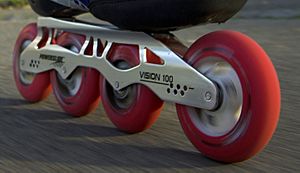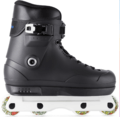Inline skating facts for kids
Inline skating is a super fun way to move around on wheels! It's like wearing special shoes that have wheels on the bottom. Unlike traditional roller skates, which have wheels in pairs, inline skates have all their wheels in a single line. This design helps skaters go faster and turn more smoothly. Many people also call this sport "rollerblading," which comes from a well-known brand of skates called Rollerblade.
Inline skates usually have between 2 and 5 wheels. These wheels are made from a strong material called polyurethane. Because the wheels are lined up, inline skates can reach higher speeds than regular roller skates.
Contents
What is Inline Skating?
Inline skating is a sport and a way to get around using special boots with wheels. It's popular for recreation, fitness, and even racing. People of all ages enjoy gliding on inline skates in parks, on paths, and even in special skate parks.
Types of Inline Skating
There are many different ways to enjoy inline skating, each with its own style and special skates.
Recreational Skating
This is the most common type of inline skating. People use recreational skates for fun, exercise, or just cruising around. These skates are usually comfortable and easy to use, perfect for beginners and casual skaters. They often have softer wheels for a smoother ride on different surfaces.
Fitness Skating
Fitness skating is all about getting a good workout. Skaters use these skates for longer distances and faster speeds. Fitness skates often have bigger wheels, which help you go faster and cover more ground with less effort. They are designed to be lightweight and breathable for extended use.
Aggressive Skating
Aggressive inline skating is for skaters who love doing tricks. This includes grinding on rails, jumping, and sliding. Aggressive skates are built to be very strong and durable. They have smaller, harder wheels and special plates for grinding. This style is often seen in skate parks and on street obstacles.
Speed Skating
Speed skating is a competitive sport where skaters race against each other. Speed skates have very large wheels and low-cut boots. This design helps skaters achieve maximum speed. The boots are often made of carbon fiber to be stiff and lightweight.
Artistic Skating
Artistic inline skating is similar to ice dancing or figure skating. Skaters perform graceful movements, spins, and jumps to music. The skates for artistic skating are designed to allow for precise control and elegant maneuvers.
Safety Gear for Inline Skating
Staying safe while inline skating is very important. Wearing the right protective gear can prevent injuries.
Helmets
A helmet is a must-have for any skater. It protects your head from serious injury if you fall. Always make sure your helmet fits snugly and is certified for skating.
Pads
Elbow pads, knee pads, and wrist guards are also very important. They protect your joints and hands from scrapes and breaks. When you fall, your knees and elbows often hit the ground first, and your hands might go out to break your fall.
History of Inline Skates
The idea of inline skates has been around for a long time. The first known inline skate was patented in 1819 by a Frenchman named M. Petitbled. These early skates were not very practical. Over the years, many inventors tried to improve the design.
In the 1970s, ice hockey players started using inline skates for off-season training. They wanted to practice their moves when there was no ice. In 1978, a company called SKF-Speedy made some early inline skates. The sport really took off in the 1980s when the Rollerblade company began making and selling improved inline skates. They became so popular that "Rollerblade" became a common name for all inline skates.
Images for kids
See also
 In Spanish: Patinaje en línea para niños
In Spanish: Patinaje en línea para niños







